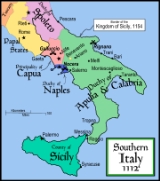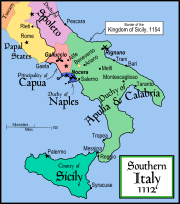
Alfonso of Hauteville
Encyclopedia

Roger II of Sicily
Roger II was King of Sicily, son of Roger I of Sicily and successor to his brother Simon. He began his rule as Count of Sicily in 1105, later became Duke of Apulia and Calabria , then King of Sicily...
and Elvira of Castile
Elvira of Castile (Sicilian queen)
Elvira of Castile was the first Queen of Sicily.- Background and upbringing :She was a daughter of Alfonso VI of Castile by his fourth queen, Isabella...
, was the prince of Capua from 1135 to his death.
He was named after his maternal grandfather, Alfonso VI of Castile
Alfonso VI of Castile
Alfonso VI , nicknamed the Brave or the Valiant, was King of León from 1065, King of Castile and de facto King of Galicia from 1072, and self-proclaimed "Emperor of all Spain". After the conquest of Toledo he was also self-proclaimed victoriosissimo rege in Toleto, et in Hispania et Gallecia...
. His maternal grandmother was Alfonso VI's fourth wife Isabel, possibly the same person as Zaida, converted daughter-in-law of al-Mutamid of Seville
Seville
Seville is the artistic, historic, cultural, and financial capital of southern Spain. It is the capital of the autonomous community of Andalusia and of the province of Seville. It is situated on the plain of the River Guadalquivir, with an average elevation of above sea level...
.
Though his birth date is unknown, he was old enough to wage war to maintain his principality when, in 1135, his father gave him the principality of Capua
Principality of Capua
The Principality of Capua was a Lombard state in Southern Italy, usually de facto independent, but under the varying suzerainty of Western and Eastern Roman Empires. It was originally a gastaldate, then a county, within the principality of Salerno....
, thus dethroning the rebellious reigning prince, Robert II
Robert II of Capua
Robert II was the count of Aversa and the prince of Capua from 1127 until his death .He was the only son and successor of Jordan II of Capua...
, of the House of Drengot. He appointed his chancellor Guarin
Guarin
Guarin was the chaplain and chancellor of Roger II of Sicily from about 1130 to his death, during the first decade of the Norman kingdom of Sicily. According to Alexander of Telese, the contemporary chronicler, he was "erudite ... and most prudent in negotiations .....
to act as the young Alfonso's administrator. This action effectually brought Capua into the sphere of Hauteville power, though Roger attended Alfonso's enthronement as suzerain, not ruler. On 25 July 1139, by the Treaty of Mignano
Treaty of Mignano
The Treaty of Mignano of 1139 was the treaty which ended more than a decade of constant war in the Italian Mezzogiorno following the union of the mainland duchy of Apulia and Calabria with the County of Sicily in 1127...
, he received the papal recognition of Innocent II, taking up the same position vis-a-vis the papacy which the old Drengot princes long held.
On the death of Sergius VII of Naples
Sergius VII of Naples
Sergius VII was the thirty-ninth and last duke of Naples. He succeeded his father John VI on the Neapolitan throne in 1120 or 1123 at a time when Roger II of Sicily was rising rapidly in power...
, who had thrown open his city's gates to Roger II, Alfonso was elected duke of Naples. In April 1140, with his elder brother Roger III
Roger III, Duke of Apulia
Roger III was the Norman duke of Apulia from 1135. He was the eldest son of King Roger II of Sicily and Elvira of Castile....
, whom their father had made duke of Apulia, he invaded the Abruzzo
Abruzzo
Abruzzo is a region in Italy, its western border lying less than due east of Rome. Abruzzo borders the region of Marche to the north, Lazio to the west and south-west, Molise to the south-east, and the Adriatic Sea to the east...
, conquering much land including the important coastal city of Pescara. He stretched his dominion as far as the Tronto
Tronto
The Tronto is a 115 km-long Italian river that arises at Monte della Laghetta and ends in the Adriatic Sea at Porto d'Ascoli, San Benedetto del Tronto. Anciently the Truentus, it traverses the Lazio, Marche, and Abruzzo regions....
river. He died on 10 October 1144 during a second invasion with his brother, this time in Latium
Latium
Lazio is one of the 20 administrative regions of Italy, situated in the central peninsular section of the country. With about 5.7 million residents and a GDP of more than 170 billion euros, Lazio is the third most populated and the second richest region of Italy...
against Pope Lucius II
Pope Lucius II
Pope Lucius II , born Gherardo Caccianemici dal Orso, was pope from March 9, 1144, until his death Feb 15, 1145. His pontificate was notable for the unrest in Rome associated with the Commune of Rome, and its attempts to wrest control of the city from the papacy.-Early life:Gherardo Caccianemici...
, where they marched on Rieti
Rieti
Rieti is a city and comune in Lazio, central Italy, with a population of c. 47,700. It is the capital of province of Rieti.The town centre rests on a small hilltop, commanding a wide plain at the southern edge of an ancient lake. The area is now the fertile basin of the Velino River...
and Cagnano Amiterno
Cagnano Amiterno
Cagnano Amiterno is a comune and town in the Province of L'Aquila in the Abruzzo region of Italy. It is located in the natural park known as the "Gran Sasso e Monti della Laga National Park"....
.
Sources
- Norwich, John JuliusJohn Julius NorwichJohn Julius Cooper, 2nd Viscount Norwich CVO — known as John Julius Norwich — is an English historian, travel writer and television personality.-Early life:...
(1970) The Kingdom in the Sun 1130-1194. Longman: LondonLondonLondon is the capital city of :England and the :United Kingdom, the largest metropolitan area in the United Kingdom, and the largest urban zone in the European Union by most measures. Located on the River Thames, London has been a major settlement for two millennia, its history going back to its...
.

